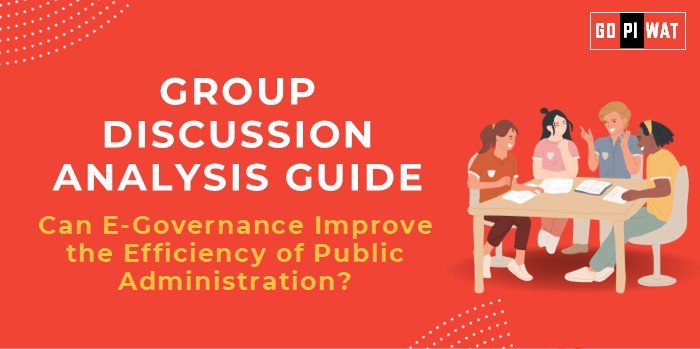📋 Group Discussion (GD) Analysis Guide: Can E-Governance Improve the Efficiency of Public Administration?
🌐 Introduction to the Topic
- Opening Context: In the digital era, governments worldwide are leveraging technology to streamline operations. E-governance, defined as the application of IT for delivering government services, has emerged as a pivotal tool for enhancing transparency, accountability, and efficiency in public administration.
- Background: India’s e-governance journey began in the mid-1990s, with initiatives like NICNET and e-Kranti under the Digital India campaign. With over 900 million internet users and extensive digital infrastructure, the potential for e-governance in India is unparalleled.
📊 Quick Facts and Key Statistics
- 📈 UPI Transactions: 11.5 billion monthly, representing robust adoption of digital platforms (2024).
- 💰 DBT Savings: ₹2.7 lakh crore saved through reduced leakages.
- 🌍 Rural Internet Access: Only 20% of rural households have connectivity.
- 🏅 Global Ranking: Estonia is a global leader in e-governance; India aims to replicate such successes.
👥 Stakeholders and Their Roles
- Government: Policy implementation, cybersecurity, and funding.
- Private Sector: Infrastructure development and service delivery innovations.
- Citizens: Active participation and feedback to enhance inclusivity.
- International Organizations: Providing expertise and benchmarking standards.
🏆 Achievements and Challenges
✨ Achievements:
- 🚀 Efficiency Gains: DigiLocker usage by 400 million+ users simplifies documentation.
- 📈 Financial Inclusion: DBT ensures subsidy delivery without intermediaries.
- ⚖️ Transparency: E-auction platforms reduce corruption.
⚠️ Challenges:
- 🌐 Digital Divide: Rural and urban disparity in internet access.
- 🔒 Cybersecurity Risks: High-profile breaches, such as the AIIMS attack.
- 📡 Infrastructure Gaps: Limited access to high-speed internet in remote areas.
🌍 Global Comparisons
- 🏅 Estonia: Seamless e-governance in tax filings and healthcare.
- 🤖 Singapore: AI-integrated public administration.
📋 Structured Arguments for Discussion
- Supporting Stance: “E-governance enhances transparency and minimizes corruption.”
- Opposing Stance: “Limited infrastructure and digital literacy hinder its potential.”
- Balanced Perspective: “While e-governance improves efficiency, its success hinges on inclusivity and cybersecurity.”
💬 Effective Discussion Approaches
- Opening Approaches:
- 📊 Use impactful statistics: “11.5 billion UPI transactions show immense digital adoption in India.”
- 📚 Present a case study: “The Kerala model of e-governance ensures 93% digital literacy.”
- Counter-Argument Handling:
Solution-oriented rebuttal: “Investments in digital infrastructure can bridge the rural-urban divide.”
🔍 Strategic Analysis of Strengths and Weaknesses
- 💡 Strengths: Transparency, cost-efficiency.
- ⚠️ Weaknesses: Limited reach, cybersecurity vulnerabilities.
- 🌟 Opportunities: AI integration, global leadership in digital governance.
- ⚡ Threats: Rising cybercrime, implementation delays.
🎓 Connecting with B-School Applications
- 📈 Real-World Applications: Capstone projects on the economic impact of e-governance.
- 🤔 Sample Interview Questions:
- How does e-governance improve transparency in governance?
- Discuss the role of cybersecurity in e-governance.
- 📖 Insights for B-School Students: Focus on technology’s role in public policy and administration.
📄 Source: GD and WAT preparation frameworks, 2024.


